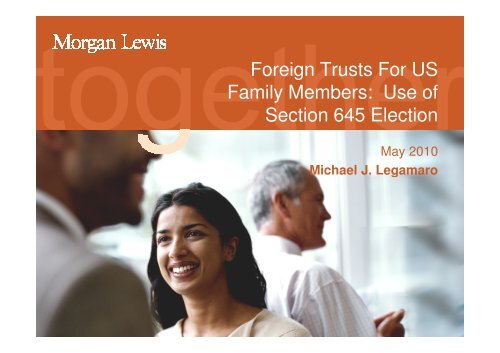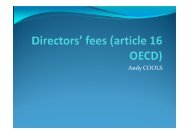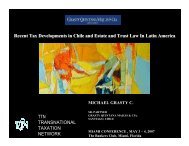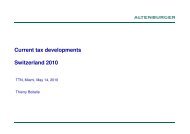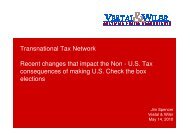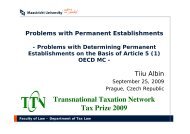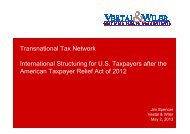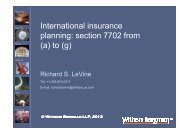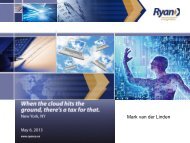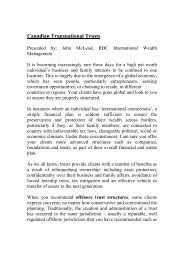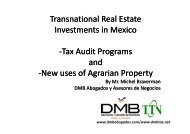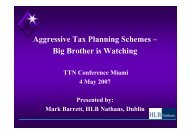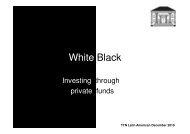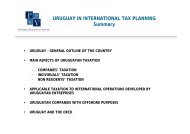Foreign Trusts For US Family Members: Use of Section 645 Election
Foreign Trusts For US Family Members: Use of Section 645 Election
Foreign Trusts For US Family Members: Use of Section 645 Election
You also want an ePaper? Increase the reach of your titles
YUMPU automatically turns print PDFs into web optimized ePapers that Google loves.
<strong><strong>For</strong>eign</strong> <strong>Trusts</strong> <strong>For</strong> <strong>US</strong><br />
<strong>Family</strong> <strong>Members</strong>: <strong>Use</strong> <strong>of</strong><br />
<strong>Section</strong> <strong>645</strong> <strong>Election</strong><br />
May 2010<br />
Michael J. Legamaro
Case Study – A Representative <strong>Family</strong><br />
• <strong><strong>For</strong>eign</strong> <strong>Family</strong> with Resident Aliens in the U.S.<br />
• Substantial Off-Shore Wealth<br />
• Primary Goal – To find a tax-effective means <strong>of</strong><br />
transferring wealth to U.S. family members<br />
• Long-term solution<br />
• Minimize or eliminate U.S. and foreign transfer taxes<br />
2
Usual Solution: The Trust<br />
• Most foreign families desiring to benefit <strong>US</strong><br />
family members (e.g., children) seek to create<br />
structures which make assets available over<br />
time.<br />
• Generally, preferred answer (given numerous<br />
issues with various alternatives) is a trust – a<br />
common law entity where trustee manages<br />
assets for the benefit <strong>of</strong> family members.<br />
3
Basic Idea<br />
• Non-<strong>US</strong> Trust established by parents to hold<br />
trust assets. May be some “home country”<br />
efficiencies, such as reduction <strong>of</strong> income tax<br />
thereon.<br />
• Income accumulates or available to family<br />
members (or maybe just parents) during their<br />
lifetimes.<br />
• At parents’ death, assets become available for<br />
children, including – occasionally family<br />
members in the United States.<br />
4
Current Year Income Distributed<br />
• A distribution <strong>of</strong> current year income – so-called<br />
“distributable net income” – is taxable to the <strong>US</strong><br />
Beneficiaries.<br />
• Distributable net income (“DNI”) includes all<br />
income from whatever source derived, such as<br />
interest, dividends, foreign source income and<br />
capital gain.<br />
• Distribution <strong>of</strong> DNI thus “carries out” income and<br />
its “character” – e.g., favorable capital gain rates<br />
where capital gain realized and distributed.<br />
5
So What’s the Problem?<br />
• Trust better not make a distribution to the <strong>US</strong><br />
family members <strong>of</strong> DNI accumulated from a prior<br />
year . . .<br />
• Or . . . Throwback Applies!<br />
6
Throwback Rules: Downright Ugly<br />
• Apply when a foreign trust makes an “accumulation<br />
distribution” to a United States beneficiary, including<br />
another trust, and that trust has “undistributed net<br />
income” from one or more <strong>of</strong> its preceding taxable years.<br />
• IRC <strong>Section</strong> 665(b) defines an “accumulation<br />
distribution” as any distribution <strong>of</strong> “any other amounts<br />
properly paid or credited or required to be distributed” to<br />
the beneficiary, to the extent that it exceeds both the<br />
trust’s distributable net income for that year (reduced by<br />
any amount required to be distributed currently) and the<br />
trust’s net accounting income for the year<br />
7
How Does Throwback Work?<br />
• Trust distributes its “accumulated income” to a<br />
United States beneficiary (including another<br />
trust). The distribution will be taxed as though<br />
the previously undistributed income had, in fact,<br />
been distributed and taxed to the beneficiary in<br />
earlier years.<br />
• The beneficiary must pay this tax for the year he<br />
or she receives the “accumulation distribution,”<br />
plus an interest charge to compensate for the<br />
delay in payment <strong>of</strong> tax.<br />
8
Come Again?<br />
• Confiscatory Regime Designed to <strong>For</strong>ce<br />
Distributions from Non-Grantor <strong><strong>For</strong>eign</strong> <strong>Trusts</strong><br />
for <strong>US</strong> Beneficiaries<br />
• All Distributions <strong>of</strong> “Accumulated Income” are<br />
taxed at (a) Ordinary Income Rates and (b)<br />
Subject to an Interest Charge for Failing to Pay<br />
Tax in Prior Years. . . OUCH!!!<br />
9
BUT . . . the Throwback Rules<br />
only apply to . . .<br />
FOREIGN NON-GRANTOR TR<strong>US</strong>TS;<br />
NOT GRANTOR TR<strong>US</strong>TS<br />
10
What is a Grantor Trust?<br />
• Generally speaking, a “grantor trust” is a trust<br />
that is treated as owned for U.S. income tax<br />
purposes by the grantor.<br />
• If the grantor is treated as the owner <strong>of</strong> a trust,<br />
then the trust form is disregarded for U.S.<br />
income tax purposes and income, deductions<br />
and credits <strong>of</strong> the trust are attributable to the<br />
grantor.<br />
11
Classic Structure<br />
• <strong><strong>For</strong>eign</strong> “grantor trust” established by parents to<br />
hold trust assets during their lifetimes.<br />
• Maybe revocable<br />
• Maybe irrevocable but treated as revocable for <strong>US</strong>;<br />
tax purposes<br />
• Income accumulates tax free during lifetime <strong>of</strong><br />
parents. At parents’ death, assets become<br />
available for <strong>US</strong> family members.<br />
12
U.S. Income Tax Advantages <strong>of</strong><br />
<strong><strong>For</strong>eign</strong> Grantor Trust Status:<br />
• All income and losses realized and assets<br />
owned by the trust are treated as realized and<br />
owned directly by the foreign grantor.<br />
• Therefore, income realized by trust/grantor is<br />
subject to U.S. income tax only on U.S. source<br />
income –mostly only dividend income.<br />
• “Distributions” to family members are deemed<br />
“gifts” and are tax free. Not subject to Throwback<br />
Rules or PFIC regime.<br />
13
Unfortunately, all goods things<br />
come to an end . . .<br />
• Grantor trust status “terminates” at the death <strong>of</strong><br />
the grantor.<br />
• At that point, the trust “springs into existence”<br />
and the normal rules <strong>of</strong> trust accounting apply:<br />
• Trust is taxable owner <strong>of</strong> income and assets.<br />
• Distributions are taxable to the beneficiary.<br />
• <strong><strong>For</strong>eign</strong> trust beneficiaries are subject to throwback.<br />
14
Entering Stage Left . . .<br />
The “<strong>Section</strong> <strong>645</strong> <strong>Election</strong>”<br />
15
<strong>Section</strong> <strong>645</strong> Planning:<br />
The Basics<br />
• IRC <strong>Section</strong> <strong>645</strong> permits a trustee <strong>of</strong> a “qualified<br />
revocable trust” and – if any – the executor <strong>of</strong><br />
the related estate, to make an election to treat<br />
the “qualified revocable trust” as part <strong>of</strong> the<br />
“estate” <strong>of</strong> the decedent<br />
• <strong>Election</strong> period last no more than 2 years<br />
following death<br />
• Qualified revocable trust with foreign settlor may<br />
make the election<br />
16
<strong>Section</strong> <strong>645</strong> Planning –<br />
Making the <strong>Election</strong><br />
• To make the election, the trust must be a<br />
“qualified revocable trust”<br />
• A qualified revocable trust is one where the settlor<br />
has the power to “revest” property in himself<br />
• Power to “revest” includes power to revoke, to<br />
terminate, to alter or amend, or to appoint the trust<br />
property<br />
• In other words, many “grantor trusts” owned by<br />
foreign settlors for <strong>US</strong> tax purposes qualify<br />
17
<strong>Section</strong> <strong>645</strong> Planning:<br />
What is the Planning About?<br />
• If DNI includes income from all sources<br />
(including interest, dividends, non-U.S. source<br />
income and capital gains) in the case <strong>of</strong> a trust<br />
And<br />
• Undistributed or accumulated DNI becomes<br />
subject to “throwback” in a later year when the<br />
trust distributes it . . .<br />
18
In the case <strong>of</strong> an Estate (Including a Trust<br />
Electing <strong>Section</strong> <strong>645</strong> Treatment)<br />
• DNI does NOT include income from non-U.S.<br />
sources and capital gains.<br />
• There is simply a different definition <strong>of</strong> what is<br />
included in DNI in the case <strong>of</strong> an estate v. a<br />
trust.<br />
• If the DNI <strong>of</strong> an estate does not include income<br />
from sources outside <strong>of</strong> the <strong>US</strong> or capital gains,<br />
that means that . . .<br />
19
Benefits <strong>of</strong> Being Part <strong>of</strong> Estate<br />
• Non-<strong>US</strong> source income and capital gains<br />
realized by the electing trust (i.e, during the<br />
<strong>Section</strong> <strong>645</strong> period) and distributed to the <strong>US</strong><br />
Beneficiary can be entirely tax-free in the<br />
hands <strong>of</strong> the <strong>US</strong> Beneficiary<br />
• Beneficiary is considered to receive “corpus”<br />
<strong>of</strong> the estate <strong>of</strong> the decedent, rather than DNI<br />
20
And . . . Maybe Even More Exciting . . .<br />
• Since capital gains and non-U.S. source income<br />
are not included in DNI, such income, if<br />
accumulated, should not be included in<br />
determining UNI.<br />
• Effect –Throwback Rules rendered inapplicable<br />
during <strong>Section</strong> <strong>645</strong> period, if foreign “estate” can<br />
generate only non-U.S. source income and<br />
capital gains during such period.<br />
21
<strong>Section</strong> <strong>645</strong> <strong>Election</strong>:<br />
<strong>Use</strong>ful Tool<br />
22
<strong>Section</strong> <strong>645</strong> Planning:<br />
Basis Step-Up Benefits<br />
• Upon the decedent’s death, step-up in the basis <strong>of</strong> trust<br />
assets may not be available under other more traditional<br />
methods (i.e., IRC § 1014)<br />
• Provided the trust is a “qualified revocable trust”, the<br />
trust may refresh trust asset basis (i.e., buy/sell) during<br />
the <strong>Section</strong> <strong>645</strong> period<br />
• <strong>For</strong> U.S. tax purposes, the basis will be adjusted to<br />
purchase price (i.e., fair market value)<br />
• Provided assets held only provide capital gain (including<br />
U.S.) and other non-U.S. source income, such churning<br />
should occur free from U.S. tax<br />
23
<strong>Section</strong> <strong>645</strong> Planning:<br />
“Checking-the-Box”<br />
• <strong>Section</strong> <strong>645</strong> basis step-up can apply in conjunction with<br />
so-called “check-the box” planning<br />
• Upon decedent’s death, CTB elections can be made for<br />
any corporation owned by the trust<br />
• CTB election is treated as taxable disposition <strong>of</strong><br />
corporate assets, which produces an adjusted basis in<br />
the underlying assets equal to fair market value<br />
• Provided assets held by corporation only provide capital<br />
gain (including U.S.) and other non-U.S. source income,<br />
such churning should occur free from U.S. tax<br />
24
<strong>Section</strong> <strong>645</strong> Basis-Step Up:<br />
Illustration<br />
• Assumed Facts:<br />
• Non-U.S. person (FP) settles foreign trust (FT) f/b/o U.S. person<br />
• FT provides FP with power to “revest”, thus it is a “qualified<br />
revocable trust” and owns:<br />
• Non-U.S. real estate (Asset 1)<br />
• Non-U.S. corporation owning a non-passive non-U.S. business<br />
(Asset 2)<br />
• A so-called “passive foreign investment company” (PFIC)<br />
• A so-called “controlled foreign corporation” (CFC) which holds only<br />
shares <strong>of</strong> stock in a publicly traded U.S. corporation (Asset 3)<br />
• Each <strong>of</strong> Asset 1, Asset 2, Asset 3, PFIC and CFC have a basis<br />
<strong>of</strong> zero and fair market value <strong>of</strong> $100<br />
25
<strong>Section</strong> <strong>645</strong> Basis-Step Up:<br />
Illustration – During Life <strong>of</strong> Settlor<br />
United States<br />
Beneficiary<br />
Nonresident<br />
Alien/Grantor<br />
FT<br />
(<strong><strong>For</strong>eign</strong><br />
Grantor Trust)<br />
<strong><strong>For</strong>eign</strong><br />
Passive Assets<br />
(Asset 1)<br />
<strong><strong>For</strong>eign</strong> Corp<br />
w/<strong><strong>For</strong>eign</strong><br />
Business<br />
(Asset 2)<br />
PFIC –<br />
Passive Assets<br />
CFC –<br />
Passive Assets<br />
(Asset 3)<br />
26
<strong>Section</strong> <strong>645</strong> Basis-Step Up:<br />
Illustration – Cont’d<br />
• Settlor dies and trustee makes a <strong>Section</strong> <strong>645</strong><br />
election<br />
• Thereafter, trustee <strong>of</strong> FT:<br />
• Sells Asset 1 for $100 at any time during <strong>Section</strong> <strong>645</strong> period<br />
• Makes a CTB election for Asset 2 at any time during <strong>Section</strong> <strong>645</strong><br />
period<br />
• Makes a CTB election for PFIC before the end <strong>of</strong> the tax year<br />
which includes decedent’s death<br />
• Makes a CTB election for CFC within 30 days <strong>of</strong> death, churns<br />
Asset 3 just prior to the end <strong>of</strong> the <strong>Section</strong> <strong>645</strong> period<br />
27
After Death <strong>of</strong> Grantor<br />
United States<br />
Beneficiary<br />
NRA’s<br />
Estate<br />
(<strong>645</strong> Electing Trust)<br />
“Churned” <strong><strong>For</strong>eign</strong><br />
Passive Assets<br />
(Asset 1)<br />
<strong><strong>For</strong>eign</strong> Corp<br />
w/<strong><strong>For</strong>eign</strong><br />
Business<br />
(Asset 2)<br />
PFIC –<br />
Passive Assets<br />
CFC –<br />
Passive Assets<br />
(Asset 3)<br />
Churning <strong>of</strong> Assets –<br />
Basis Step-Up to<br />
Passive Assets<br />
“Check-the-Box” <strong>Election</strong>s –<br />
Basis Step-Up to<br />
Underlying Assets<br />
28
<strong>Section</strong> <strong>645</strong> Basis-Step Up:<br />
Illustration – Results<br />
• Asset 1: FT will receive $100 to reinvest, and new asset will have a<br />
cost basis (i.e., $100)<br />
• Asset 2: CTB election will cause a deemed sale <strong>of</strong> underlying<br />
assets – basis stepped up to FMV (underlying assets can be<br />
refreshed before end <strong>of</strong> <strong>Section</strong> <strong>645</strong> period)<br />
• PFIC: CTB election (must be made before end <strong>of</strong> year <strong>of</strong> death) will<br />
cause a deemed sale <strong>of</strong> underlying assets -- basis stepped up to<br />
FMV (underlying assets can be refreshed before end <strong>of</strong> <strong>Section</strong> <strong>645</strong><br />
period)<br />
• CFC: CTB election (must be made within 30 days <strong>of</strong> death) will<br />
cause a deemed sale <strong>of</strong> underlying assets -- basis stepped up to<br />
FMV (underlying assets (i.e., Asset 3) can be refreshed before end<br />
<strong>of</strong> <strong>Section</strong> <strong>645</strong> period)<br />
29
<strong>Section</strong> <strong>645</strong> <strong>Election</strong> and PFIC Rules<br />
• Unfortunately, <strong>Section</strong> <strong>645</strong> election does not<br />
protect against PFIC treatment commencing in<br />
year following Grantor’s death<br />
• Sales/dispositions <strong>of</strong> PFICs occurring in year<br />
after Grantor’s death are subject to adverse<br />
PFIC taxation<br />
• So . . . The <strong>Election</strong> is not a “cure-all”.<br />
30


